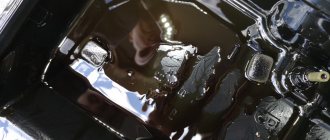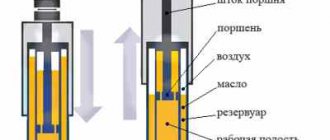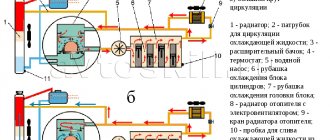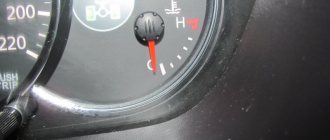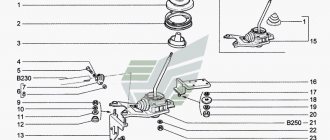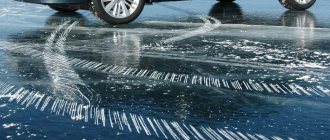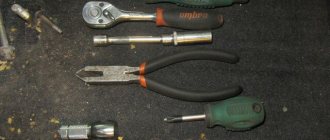How to do slipping on the spot?
Some people consider spinning to be pranks that young people do for fun. But it is not always the case. In drag racing, skidding heats up the tires. The slipping technique will vary depending on the type of transmission.
How to slip on a manual transmission?
In order to start slipping in a car with a manual transmission, press the brake and gas pedals at the same time. At the same time, do not press the brake pedal all the way. The engine picks up speed, and when to release the clutch is up to whoever is driving.
How to slip on an automatic transmission?
Without harm to the car, you can slip with an automatic transmission using neutral. Naturally, each gearbox has its own characteristics, but before you start drifting in place, it’s a good idea to read the instruction manual.
Recommendations
There are some rules regarding proper slippage.
- You can’t skid in place for a long time, because the gearbox needs rest. Skid periodically, so both the driver and the car will rest. There is no need to turn off the engine while resting.
- You cannot skid on a cold car. Hasty actions will lead to wear of significant parts of the automatic transmission, since slipping will begin without any lubrication of the mechanism.
- Before attempting to drive out of a snowdrift, turn on R mode, first pressing the brake pedal. We stand in this position for at least a minute. During this time, the required amount of lubricant will be pumped through the torque converter.
- When skidding, you should avoid too sharp traction with the road. The higher the load, the faster the clutches on the automatic transmission will fail.
Which cars are not suitable for towing?
- Low efficiency of the cooling system can provoke a critical condition due to increased heat generation in the torque converter. The radiator will become clogged with wear products. Such difficulties are typical for cars with high mileage. Let's include here all American cars produced back in the 80s and 90s.
- Older Japanese and European cars have air transmission cooling systems. This means that the automatic transmission is cooled while driving, and therefore slipping on them can only be to the detriment of the “health” of the car. True, there are practically no such cars in Russia anymore, since they are small cars that rarely hit our market.
If you follow these simple rules, you can skid without causing any harm to your iron horse. You don’t want to pay for expensive repairs or buy new tires because of a simple mistake? Always be careful when driving.
What happens to an automatic transmission when it slips?
The consequences of the machine slipping are fraught with major repairs of the automatic transmission. As the temperature inside the machine rises, the friction force of the metal parts against each other increases.
Automatic transmission components suffer:
These are just the main three reasons. If there is frequent slipping, the vehicle will be constantly under repair. Therefore, experts say that you should not skid with an automatic transmission.
Attention! If the car owner skids for a long time, then the electronic mechanisms of the machine can independently block the engine and go into emergency mode to protect themselves from overheating.
But in the Russian climate it is very difficult in winter not to stall in a snowdrift. Experienced car owners install an additional cooling radiator on the machine. It will help cope with overheating of the transmission fluid not only during slipping, but also in the summer.
How to slip?
Some people consider spinning to be pranks that young people do for fun. But it is not always the case. In drag racing, skidding heats up the tires. The slipping technique will vary depending on the type of transmission.
How to slip on mechanics
In order to start slipping in a car with a manual transmission, press the brake and gas pedals at the same time. At the same time, do not press the brake pedal all the way. The engine picks up speed, and when to release the clutch is up to whoever is driving.
How to slip on automatic
Without harm to the car, you can slip with an automatic transmission using neutral. Naturally, each gearbox has its own characteristics, but before you start drifting in place, it’s a good idea to read the instruction manual.
Recommendations
There are some rules regarding proper slippage.
- You can’t skid in place for a long time, because the gearbox needs rest. Skid periodically, so both the driver and the car will rest. There is no need to turn off the engine while resting.
- You cannot skid on a cold car. Hasty actions will lead to wear of significant parts of the automatic transmission, since slipping will begin without any lubrication of the mechanism.
- Before attempting to drive out of a snowdrift, turn on R mode, first pressing the brake pedal. We stand in this position for at least a minute. During this time, the required amount of lubricant will be pumped through the torque converter.
- When skidding, you should avoid too sharp traction with the road. The higher the load, the faster the clutches on the automatic transmission will fail.
"Crank" on "automatic"
It's not that simple here
as it seems to some. It is possible to slip only if the road is slippery: ice, snow, or, in extreme cases, sand on the beach. You can't do this on asphalt. They say that some people manage to make a crank in the “neutral” mode on an automatic transmission, but one hardly believes in such fables.
Let's simulate the situation:
stuck in a snowdrift and need to get out with an automatic transmission. To do this, engage the “R” gear, before doing this we squeeze the foot brake.
In this mode, we wait about 3 minutes until the oil is pumped up by the torque converter and gradually begin to release the brake, increasing the speed. High speeds will quickly damage the automatic transmission clutches. Minimal cooling may cause the liquid to boil.
In a word, slipping is allowed, but within moderate limits.
Therefore, if you really want to learn the art of drag racing, first take training courses at any driving school and only after that feel free to get behind the wheel of your car. Actually, they gave a full answer to the question: how to skid on the spot. Always make an informed decision.
Source
What to do if you are stuck on front-wheel drive?
Let's consider several possible situations:
- If the left wheels are on the asphalt (or any other hard surface), and the right wheels are on the side of the road (or in a snow and mud “mess”), then you do not need to reduce or increase the speed and under no circumstances should you turn off the gear. We smoothly bring the car onto a hard surface without changing the pressure on the gas pedal.
- If, while the car is moving, all four wheels are on the side of the road (snowy road, snow and mud “porridge”), then you need to turn on a lower speed and increase the pressure on the accelerator pedal (this way, with the front wheels driving, it is easier for you to stabilize the movement). We smoothly drive the car onto a hard surface.
- If you are stopped in a snowy area and cannot start moving due to wheel slip. Remember: when you press the gas pedal, a front-wheel drive car “lifts” the front end, thereby redistributing the weight of the entire car to the rear, which is worth taking advantage of in this situation. We engage first gear, and by briefly pressing the gas pedal we “rock” the car back and forth (successive presses: gas pedal - clutch pedal - gas pedal - clutch pedal and so on), without changing the position of the steering column. When the wheels begin to cling to the surface, we gradually increase the speed.
- If after the previous steps you were unable to leave, then you need to manually clean the coating near the front wheels (it is recommended to have a small shovel with a short handle in the trunk in the winter). It is necessary to clean a distance of about 50 centimeters from each wheel. If you do less, there is a high probability that you will pass the cleared area and skid again, since the inertia of movement will be minimal.
- What to do if you skid on an icy section of the road while climbing? In this case, you need, without turning off the gear, slow down, switch to a lower gear and gradually increase the speed (to approximately 1400-1500 rpm). If you sharply increase the speed, then slippage is inevitable.
Front wheel drive cars
III. On front-wheel drive, burnout slipping is somewhat easier than on rear-wheel drive. To do this, you need to hold the parking brake, then raise the engine speed and just as smoothly and quickly release the clutch pedal. As a result of such a rapid (almost instantaneous) increase in speed of rotation of the front wheels, the car will not move forward and will not stall; remaining in one place, it will begin to release the desired and long-awaited puffs of smoke from under its tires.
On front-wheel drive, it is much easier to do burnout-slip. But there is one important nuance, namely: the car’s handbrake must be in good working order, it must be able to hold the car in one place.
Motorbike
On a motorcycle it is enough to install side protection, because... During training, you can turn the bike on its side. A machine with easy clutch release will come in handy, because... You will have to constantly depress the clutch. With a standard machine, your fingers will get tired much faster. The pressure in the rear wheel does not matter much. The standard one is quite suitable for training. It is advisable to adjust the brake lever so that it is as close as possible to the steering wheel. This will reduce the stress on your fingers and allow you to feel the brakes better.
Tips for beginners
How not to stall
If the speed drops sharply, and the car shakes violently, you need to either increase the engine speed (“give it gas”), or slightly increase the pressure on the clutch pedal, but under no circumstances release it completely.
There is nothing scary about stalling on a hill; it’s much worse about rolling back, because in real conditions there is a high probability that there is a car behind you. Just repeat all the previous steps correctly again: shift the gearbox to neutral, start the car and try to drive off.
How to avoid jerking
Always check the position of the gear shift lever; a characteristic sign of the neutral position is free movement to the right and left. Better yet, start the car with the clutch depressed, this will avoid a sharp jerk forward if you suddenly forgot to turn off the gear.
Don't worry
Remember: at first, your main enemy is excitement, do not pay attention to the sound and light signals of impatient drivers, they simply forgot how scary and difficult it is to start with a manual transmission at first.
And when you become an experienced driver, do not forget how difficult it is for a beginner and be more tolerant of those who are “stupid on the road.” Perhaps he just hasn’t learned how to move correctly yet.
Burnout standing still
This is the easiest way! You can start with the front wheel resting against the wall.
- Do not release the gas while releasing the clutch, i.e. keep stable. You instinctively want to turn off the gas, but you can’t do this.
- Press as hard as possible on the fork when releasing the clutch, i.e. stand up on your hands.
- Completely block the front wheel. Do not slow down, but press the front brake firmly and do not release. At first, it will not be easy to hold the brake depressed and twist the gas.
How to move off smoothly with a manual? Save the clutch and nerves
Don't damage the clutch or how to start smoothly on a manual. It may seem to some that this topic is no longer relevant, since automatic transmissions and CVTs have long been on the street. I have to agree, but on the other hand, not everyone can afford to buy a car with this type of transmission, and some driving schools in the periphery continue to teach manuals. So, in the next 15 (or even 25) years we will definitely learn to drive manuals. Despite the fact that an automatic transmission and its modern hybrids cannot convey everything that you can feel when holding the gearbox. So, if you are a novice driver and want to learn how to drive a car, read the recommendations in our instructions. Algorithm How to move off smoothly with a manual transmission? To answer the question, let's look at the process of how a driver should crash:
- We sit in the driver's seat. Having previously seated an experienced driver next to you. You don’t have to take it, so as not to yell in your ear;
- Fasten your seat belt;
- Insert the key into the ignition switch. There are usually three modes on the lock: off, mass, start;
- Squeeze the handbrake to prevent the car from moving arbitrarily, set the gear to neutral;
- Only after all this can you start turning the key to the start position. After waiting for the engine to start, release the key, it will return to the “ground” position. If for some reason it was not possible to start, repeat the procedure again;
- Start the engine, the speed on the tachometer should show about 900-1000 rpm. *The tachometer is a dial with a scale located on the left side of the instrument panel;
- Having made sure that there are no obstacles on the left and right, depress the clutch pedal, the leftmost one, and engage first gear with the rocker;
- Holding the steering wheel with your hands, looking only forward and not your feet, gradually release the clutch pedal and simultaneously press the gas pedal. The main thing for yourself is to work out the synchronization of pressing and releasing. Otherwise, the car will jerk or the engine will stall, thereby causing damage to it, which can lead to breakdowns;
- If you did everything correctly, you should get the car moving. If not, then read point 8. You probably released the gas abruptly and didn’t press the gas all the way. The engine stalled and the car jerked, and for complete “happiness” a blow to the engine was heard, which meant the speed was not turned off. I think I hit the nail on the head with 99.9% agreement;
- To consolidate the stage. You must repeat step 9 from the beginning.
Burnout in a straight line
The main difference from burnout on the spot is that burnout must be turned on while moving. In fact, it's easier, because... You can additionally load the fork by braking the front wheel. Therefore, while driving, the rear wheel can be torn off at low speeds (4-6 thousand).
- Shift your body weight forward as much as possible, standing on your toes if necessary. At first it will seem like you'll fly over the steering wheel. If you don't stop abruptly, you won't fly over)
- Always cool the front brake. After a few tries the front brakes become very hard.
- Don't be afraid to ease up on the front brake to go faster. Even if you completely release the front brake, nothing bad will happen: the motorcycle will begin to quickly accelerate in a straight line and the axle box will gradually become engaged.
Why is skidding not recommended?
An automatic transmission is a very complex unit; here, torque from the engine is transmitted using pressure (or, scientifically speaking, using friction) of a fluid. Read this article , it’s about the automatic transmission clutch. In short, two disks directed at each other, enclosed in a torque converter, transmit torque from the engine to the transmission - one begins to rotate and creates fluid pressure, with the help of which the second also begins to rotate, as if everything is elementary.
But such a structure is a direct source of heat, I would even say excess heat, which is why the ATF fluid must be of very high quality and not burn. The second link that heats the oil inside is the friction discs; they can also overheat when rotating.
That’s why modern automatic transmissions now have a fluid cooling radiator installed, it’s mandatory! It takes the heat that is generated inside and dissipates it outside, due to the blowing of incoming air, as well as from the fan of the main engine cooling radiator (usually mounted next to it). After all, even traffic jams, without much slipping, can heat up the machine quite strongly, and you are standing still, so the airflow turns on to rid the machine of excess heat.
Now let's imagine slipping in snow or mud, what's happening?
You stand still - the car is slipping, the pressure and friction of the fluid inside the torque converter is INSANE, and the temperatures of the friction discs are also increasing. This causes the liquid inside to boil! There is no airflow, the car is standing still, the engine fan turns on, but it is not able to dissipate the amount of heat generated. That is, normal boiling occurs inside. I really want to make a reservation - this is when you skid for a really long time, say more than 15 minutes, constantly without rest.
Why is this detrimental to automatic transmissions:
- The torque converter suffers greatly from high temperatures; it can simply warp, because it not only heats up, it is also subject to pressure. I personally saw what broke the blades.
- Friction discs. As we have already discussed , they are divided into two types - metal and soft, usually made of pressed and impregnated paper (in other words, cardboard). For them, high temperatures (boiling) are very destructive, they begin to simply disintegrate. Sometimes they even stick to metal discs. And this is already 100% repair.
- ATF fluid also has a limit. After it boils, if the temperature continues to rise, it begins to “burn”, like all oils (even engine oils). And after this has happened, it loses its lubricating properties and begins to thicken, and in the most difficult cases, precipitate. Thus, not only is the box not effectively lubricated, but the liquid also begins to clog all the channels, for example the cooling radiator, valve body, and oil pump.
Here are the answers to all your questions. This is why many manufacturers install alarm systems on the dashboard, which can forcibly turn off your transmission when you skid too much! I think this is very correct! The car maintains its assembly itself.
Burnout eight
Burnout figure eight consists of circles, so you need to learn to circle in both directions. It makes sense to learn circles if you consistently achieve controlled movement in a straight line.
- Before entering a circle, it is better to reduce the speed with the front brake. When the front wheel rotates slowly, the skid occurs with less inclination, making it easier to get out of the circle, because You won’t have to dampen the tilt with strong pressure on the steering wheel.
- It is advisable to run laps at high speeds. This is necessary so that there is a reserve of revolutions when they need to be reduced. If the rpm drops to idle, the motorcycle will stall.
- Concentrate more on the handlebars than on the footpegs. You need to tilt the motorcycle by transferring your body weight to your hand, and not by pressing your foot on the footrest.
- Before leaving the circle, you need to loosen the front brake so that the motorcycle levels out and goes in a straight line. It is advisable to reduce the speed so that the output is softer.
If you have any comments or additions, write to us and we will update the article!
We made a compilation of the most interesting moments that we managed to capture. Everyone was included in the video: from scooter riders to world champion Marcin Glowatski!
The experience of pro-riders and amateurs has shown that often screwed-in construction screws with a flat head and protruding 1-1.5 cm work well for stunt bikes. The reliability of fixing the studs depends on the type of cord and tread thickness. It is not advisable to use worn rubber with this studding method.
For a standard set of tires (120 front and 180 rear) it took us about 10,000 screws. Screwing in self-tapping screws is tedious, but you can master it in a few days at a leisurely pace. The rubber gained a lot of weight and became stiffer.
The wheel rims have a recess for the valve on the inside. To prevent the camera nipple from rubbing against the edges, it is advisable to place a gasket or rubber washer, which can be made from an old valve.
If the automatic transmission is slipping, there are reasons for that.
Hydraulic unit
In some cases, the cause of automatic transmission slipping is clogged valve body channels, which do not provide high-quality lubrication to the moving elements, which in turn leads to slipping of the clutches. In this case, automatic transmission slipping
can be eliminated by cleaning the valve body. The valve body channels are cleaned using special compounds or ultrasound. Modern technologies make it possible to effectively clean oil supply channels from scale and old oil. It should be remembered that this work is performed exclusively with the dismantling of the hydraulic unit and takes several days.
Pump and solenoid block
It is necessary to simultaneously change the filter elements and oil in the gearbox while cleaning the valve body. In most cases, when cleaning the valve body, the solenoids are replaced, which also become unusable from the use of old and low-quality oil. The pressure in the lubrication system is measured, which allows you to determine if there are problems with the solenoids. In the event that the pressure is low and the automatic transmission slips when hot
, there may be problems with the pump or solenoids. In this case, the failed elements are replaced, which allows the transmission to return to full functionality. If it is necessary to replace solenoids in an automatic transmission, we recommend performing this work with solenoid packs, which will ensure their correct and trouble-free operation for a long time.
Clutches
Simultaneously with assessing the condition of the valve body when the gearbox slips, the clutches are inspected. During operation, clutches can wear out and become unusable. As a rule, after a mileage of 250 - 300 thousand kilometers, the degree of wear is such that the gearbox clutches have to be replaced. This work presents significant difficulties, since it is necessary to remove the gearbox from the car and completely disassemble it. For this work, special equipment is used, which allows not only to correctly perform dismantling work, but also to assess the condition of the moving elements inside the automatic transmission.
Set of new friction discs for automatic transmission
Automatic transmission ECU (Electronic control unit)
In some cases, the cause of gearbox slipping may be improper operation of the transmission control unit. In this case, electronic brains send incorrect signals to mechanical moving elements, which leads to their slipping. In this case, the problem can be solved by replacing the control unit. Note that diagnosing such breakdowns is not difficult. If the control unit fails, this will be immediately displayed during computer diagnostics of the transmission. In this case, the cost of repair depends on the specific car and the specific transmission. It must be remembered that, despite the apparent simplicity of the work, due to the high cost of the failed control unit itself, the total cost of repairs will be quite significant.
Burnout technique, what you need to know about wheel slip on the spot: Video
WARNING! DO NOT USE THE BURNOUT TECHNIQUE IN PLACES OF LARGE CLOCKS OF PEOPLE AND ON PUBLIC ROADS!
Burnout, an effective technique for warming up tires or a spectacular way to show off in front of others. In any case, the ability to do a burnout will help you get a better feel for a car with a manual transmission and ruin a couple of tires.
An expert in auto mechanics and physics, Jason Fanske from the YouTube channel “Engineering Explained” again held a cultural education for his viewers. In a new form, Jason explained in detail the basics of the burnout technique, citing as an example his rear-wheel drive Honda S2000 with a manual transmission.
First, the video explains in what cases this technique is used and why it is needed.
-The coefficient of adhesion of cold tires to the road surface may be low and if necessary, it needs to be increased. If you warm up your tires, their temperature will increase, they will become softer and their grip will increase. Where is it used? Mainly in drag racing.
It is further mentioned (1.26 min video) that the process on an automatic transmission is quite simple. Press the brake, then press the gas. As soon as the wheels to which the drive is driven begin to rotate, weakening and increasing the pressure on the brake pedal, it is necessary to regulate the rotation of the wheels and prevent the car from moving.
Inscription at the top: Make sure the traction control is turned off!
On cars with a manual transmission, the narrator continues, everything is somewhat more complicated (1.47 min video). To do this you need:
- Depress the clutch
- Engage first gear
- Lightly press the accelerator pedal, release the clutch and immediately press the brake pedal with your left foot
As soon as you manage not to stall at this moment or to avoid slipping forward (in particular, due to the likelihood of uncontrolled acceleration of the car, burnout is so dangerous both for those around you and for the driver himself), proceed to working with the brake and gas pedals, also , as with an automatic transmission.
In addition to the equipment itself, the video mentions that it is extremely important to know at what speed the wheels of your car begin to slip on the asphalt. In the S2000, the author says, slippage begins at approximately 5,000 rpm. If you overclock the engine, there is a danger of burning the clutch instead of the tires; if the engine speed is not enough, the car will not have enough torque to overcome the grip of the tires on the road surface.
And finally, at 2.48 minutes of the video it shows how hot the tires are during a burnout. Note that the first few attempts were unsuccessful, but even so, the tire temperature increased by 4 degrees, from 15 to 19 degrees Celsius. Moreover, the inner side of the tire heated up the most, up to 20 degrees, due to the reverse camber of the wheels.
At the end of the action, the tires were heated to 160 degrees Celsius!
This is such an interesting educational program in the world of sports and automotive extremes.
Information publication: Traffic police news, accidents, traffic fines, traffic police, Online traffic rules exam. Technical inspection
Rear-wheel drive vehicles
II. Engage first gear, then fully depress the clutch and gradually begin to increase engine speed. With a quick but smooth movement, begin to release the clutch pedal, while still pressing the gas.
Attention. To prevent the speed from going into the red zone, work with the gas pedal very carefully; you do not need to press it all the way to the floor. The ideal execution technique is shown in the following video (1.00 minute video). Play with the gas pedal, alternately pressing it harder or weaker, while constantly keeping the speed high, but also safe for the engine.
Once the clutch is fully released, place your left foot on the brake pedal. In order to press the brake pedal with the required force with your left foot, some practice is required. It’s very difficult to do this the first time (and sometimes the tenth).
The braking force must be more than sufficient, and this is necessary so that the rear wheels of the car continue to rotate freely, while the car itself remains in place or continues to move very slowly forward.
Attention . Attempting to do a burnout for the first time, of course, will initially fail over and over again, and this will continue until you learn to feel the smallest nuances of the car's behavior. In this case, there is a possibility of overheating of the clutch itself, up to its failure. So try to monitor any unusual and foreign odors that appear in the car’s interior, as well as the behavior of the car itself when you turn on the gearbox and depress the clutch, precisely at the moment the clutch discs come together.
Not enough power under the hood
IV. If the car does not have enough power for such experiments, in this case, experts have some tricks in stock that help one hundred percent prevent the wheels of the car from slipping.
1. Lighten your car, especially for rear-wheel drive cars. There should be nothing unnecessary in the trunk, not even a spare tire. Before arriving at the site, take care of this in advance. The car's axle will be slightly unloaded, and it will be easier for the wheels to slip.
2. Burnout - slipping on a chip. Rolling back at low speed with the clutch depressed, you do almost everything the same as the previous times. Release the clutch, then press the gas, but do not press the brake. As a result of the influence of multidirectional forces, one of the forces will be directed downward, and the engine force will be directed in the opposite direction, that is, it will pull upward; in this case, the car will remain in place without the brakes applied.
3. Try this on a wet surface. The grip on the asphalt will be much weaker than it would be in dry weather, and this will definitely increase your chances of success.
V. And in conclusion. To reduce stress on the braking system itself, use the Brake line locking system, i.e., a lock. After installing it on the car and pressing the button, it will automatically turn off the rear brakes. This will simplify your task and keep the car in its original technical condition.
